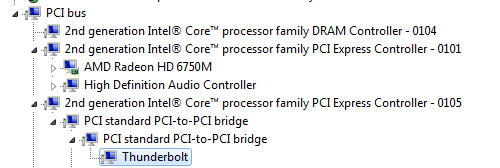Promise Pegasus R6 & Mac Thunderbolt Review
by Anand Lal Shimpi on July 8, 2011 2:01 AM ESTWindows Support
I've got good news and bad news for Windows 7/Boot Camp users. If you're using the Pegasus as a pass through for a 27-inch Cinema Display, your monitor will still work under Windows 7. Unlike what we saw when Apple first introduced the MacBook Pro, there's now a Thunderbolt device listed in Device Manager. As we mentioned in our review of the MacBook Pro, the Thunderbolt device branches off 4 PCIe lanes from the Sandy Bridge CPU itself:

The bad news is that neither Promise nor PMC Sierra have published Windows drivers for the PM8011 SAS/SATA RAID controller - the Pegasus is currently unavailable under Windows.
There's some more bad news. With the Pegasus attached, you lose the ability to put your machine to sleep under Windows. Sleep works totally fine under OS X, just not under Windows with a Thunderbolt device attached. Target display mode isn't supported under Windows either.
There are a couple more quirks that exist under Windows. Apparently you can't use the ExpressCard slot while a Thunderbolt device is connected to your MacBook Pro under Windows. And finally if you have a Thunderbolt device connected and choose to eject it using the taskbar tool, you can't reactivate the device without restarting Windows. This last quirk doesn't really apply yet since there is no Windows driver support for the Pegasus, but these issues do seem a little worrisome for Thunderbolt adoption under Windows. It remains to be seen whether these are Boot Camp issues or broader problems that will impact all Windows implementations of Thunderbolt.










88 Comments
View All Comments
Conner_36 - Friday, July 8, 2011 - link
Or even in the office, to able to take your entire project and move between the rooms carrying ALL of the data? That's unheard of!From what I understand with HD movie editing I/O is the bottleneck.
All we need now is an SVN hardware device with thunderbolt to sync across multiple thunderbolt RAIDs. Once thats out you could have a production studio with some real mobile capabilities.
Exodite - Friday, July 8, 2011 - link
I wager pretty much any usage scenario can come up with a high-performance 12TB storage solution for significantly less than 2000 USD.You're right though, it's definitely not the solution for me.
Or anyone I know, or am likely to ever know. *shrug*
Zandros - Friday, July 8, 2011 - link
What happens if you try the Macbook Pro -> Pegasus -> iMac in Target Display Mode -> Cinema Display connection chain?Focher - Saturday, July 9, 2011 - link
Pretty sure the DP monitor has to be the last device in the chain. Maybe that is just a current limitation because there are no Thunderbolt displays.Zandros - Monday, July 11, 2011 - link
AFAICT, the iMac is a Thunderbolt display, since it does not support Target Display Mode from Display Port sources with Display Port cables.tipoo - Friday, July 8, 2011 - link
Is there a way to make it shut off the drives after idling for a while?piroroadkill - Friday, July 8, 2011 - link
But when you saw the file creation maxed out at 9TB, on 10TB array..Since.. uh, Snow Leopard, Apple changed file and drive sizes to display decimal bytes as used by the manufacturers, which is the same as the 10TB array.
However every other thing ever reports in binary bytes, such as windows describing "gigabytes" even though it means gibibytes in reality.
Ugh, anyway, what I'm trying to get at is that maybe you did infact fill the array. That said, the thing shouldn't have fucked up..
CharonPDX - Friday, July 8, 2011 - link
If I had way too much money, my usage model for Target Display Mode would be to use the iMac as a Virtual Machine host/server, connected to either a second iMac or a MacBook Pro as a dual-screen workstation.With the minimum 27" iMac, you're basically buying a 27" Cinema Display plus a $700 Mac mini-on-steroids. If you want a second Apple display for your iMac or MacBook Pro, and want a Mac Mini to use as a server, that is an excellent value to instead just get a second iMac. (That value may drop depending on the next Mac Mini update, of course.)
etamin - Friday, July 8, 2011 - link
in the block diagram on the first page, why is the Thunderbolt Controller connected to the PCH thru PCIe rather than to the processor? I thought PCIe connections came off the processor/NB?repoman27 - Sunday, July 10, 2011 - link
The lanes that come off the processor/NB are usually used for dGPU. On the new MacBook Pros, Apple borrowed four of them for the Thunderbolt controller. Apparently on the new iMacs, however, they decided to give all 16 lanes from the CPU to the graphics card and pulled four from the PCH instead.